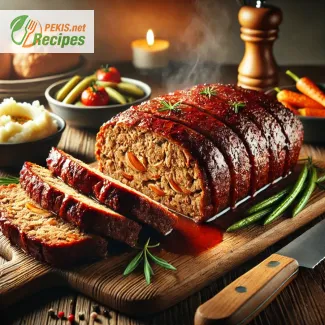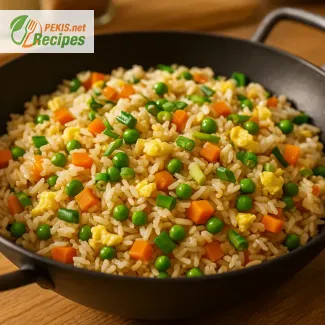
The Ultimate Guide to a Juicy and Flavorful Beef Meatloaf
A Comforting Classic for Every Occasion
There’s something truly nostalgic and comforting about a well-made beef meatloaf. This timeless dish, beloved by generations, brings warmth to the table with its tender, juicy texture and rich, meaty flavor. Whether you remember it from your grandmother’s kitchen or are making it for the first time, a perfectly prepared meatloaf is the epitome of home-cooked goodness.
The beauty of meatloaf lies in its simplicity. It requires basic pantry ingredients, minimal prep work, and a straightforward cooking process, making it the perfect choice for a weeknight dinner or a weekend family gathering. But don’t be fooled by its simplicity—when prepared correctly, a meatloaf can be succulent, flavorful, and utterly satisfying.
In this guide, we’ll explore what makes a classic beef meatloaf truly exceptional, from choosing the right ingredients to mastering the perfect texture.
Why This Classic Beef Meatloaf Stands Out
There are countless meatloaf recipes, but not all deliver that moist, flavorful bite that keeps you coming back for more. This particular recipe strikes the perfect balance of seasonings, binders, and cooking techniques, ensuring that every slice is tender and juicy, never dry or crumbly.
So, what makes this recipe special?
1. The Perfect Blend of Ingredients
A great meatloaf starts with high-quality ground beef, ideally with an 80/20 fat ratio, which provides the perfect balance between flavor and moisture. Leaner beef can result in a dry texture, while fattier meat may become overly greasy.
To elevate the taste and texture, we incorporate:
- Breadcrumbs – These act as a binder and help absorb moisture, preventing the meatloaf from falling apart.
- Eggs – Essential for binding all the ingredients together.
- Milk – A key ingredient for keeping the meatloaf moist and tender.
- Onions and Garlic – Freshly chopped for a deep, rich flavor.
- Worcestershire Sauce – Adds a subtle tang and umami depth.
- A Blend of Seasonings – Salt, pepper, and a touch of smoked paprika for warmth and complexity.
2. The Secret to a Juicy Texture
Many home cooks struggle with dry meatloaf, but the secret to keeping it juicy is all about moisture retention. By incorporating a combination of milk and breadcrumbs, the mixture stays hydrated, allowing the meat to cook evenly without drying out.
Another crucial technique is not overmixing the meat. Handling the beef too much compacts it, resulting in a dense and tough loaf. Instead, a gentle mix ensures a light, tender texture.
3. The Signature Glaze – Sweet, Tangy, and Irresistible
No meatloaf is complete without a rich, flavorful glaze. A combination of ketchup, brown sugar, and a touch of mustard creates a sweet and tangy coating that caramelizes beautifully in the oven, giving each bite a perfect contrast of flavors.
Brushing the glaze on in layers during baking ensures a sticky, glossy finish that enhances every slice.
Tips for Making the Best Homemade Meatloaf
Creating an incredible meatloaf is about more than just following a recipe—it’s about mastering a few essential techniques that take it from ordinary to extraordinary.
1. Use a Loaf Pan for Shape, but Let It Breathe
A loaf pan provides a structured shape, but using a baking sheet with parchment paper allows for better airflow, which results in a more evenly cooked meatloaf with a slightly crispy exterior.
2. Let It Rest Before Slicing
After baking, it’s tempting to dive right in—but allowing the meatloaf to rest for 10 minutes helps the juices redistribute, ensuring a moist and flavorful slice every time.
3. Customize with Your Favorite Add-Ins
While this recipe sticks to classic flavors, you can easily personalize it with ingredients like grated cheese, chopped bell peppers, or a hint of hot sauce for an extra kick.
Serving Suggestions – What Pairs Best with Classic Meatloaf?
This hearty dish is best enjoyed with classic comfort food sides that complement its rich flavors. Some excellent pairings include:
- Creamy Mashed Potatoes – A buttery and smooth counterpart to the savory meatloaf.
- Roasted Vegetables – Caramelized and slightly crisp, adding balance to the dish.
- Buttery Dinner Rolls – Perfect for soaking up any extra sauce or glaze.
- Steamed Green Beans or Asparagus – A light and fresh addition to round out the meal.
For an extra indulgent experience, serve the meatloaf with homemade gravy drizzled on top or a side of coleslaw for a refreshing contrast.
A Timeless Favorite for Any Occasion
Whether you’re making this classic beef meatloaf for a cozy family dinner, a holiday gathering, or simply to enjoy leftovers the next day, it’s a dish that never disappoints. The combination of tender beef, savory seasonings, and a mouthwatering glaze makes every bite irresistible.
With just a few simple ingredients and easy-to-follow steps, you can create a restaurant-quality meatloaf in your own kitchen. Get ready to impress your loved ones with a meal that’s as comforting as it is delicious!
- Preheat the oven to 180°C (350°F). Line a baking sheet with parchment paper or lightly grease a loaf pan.
- Prepare the mixture: In a large mixing bowl, combine the ground beef, breadcrumbs, milk, eggs, onion, garlic, Worcestershire sauce, salt, pepper, and smoked paprika. Gently mix with your hands until all ingredients are just combined—do not overmix to keep the meatloaf tender.
- Shape the meatloaf: Transfer the mixture to the prepared baking sheet or loaf pan, forming a compact loaf shape.
- Prepare the glaze: In a small bowl, mix together the ketchup, brown sugar, and mustard.
- Apply the glaze: Brush half of the glaze over the top of the meatloaf before baking.
- Bake the meatloaf for 50 minutes, then remove it from the oven and apply the remaining glaze.
- Continue baking for another 10 minutes, or until the internal temperature reaches 70°C (160°F).
- Rest before slicing: Allow the meatloaf to rest for 10 minutes before slicing and serving.
Elevating the Classic Meatloaf – Tips for a More Flavorful and Juicy Dish
Small Changes That Make a Big Difference
Meatloaf is a staple in many households, offering a hearty and satisfying meal that is both simple and comforting. However, even a classic recipe can be enhanced with a few thoughtful modifications. Whether you're looking to add more moisture, intensify the flavors, or make it healthier, small adjustments can elevate this dish to a whole new level.
Choosing the Right Meat for the Best Texture
One of the most critical components of meatloaf is the ground beef itself. The fat content of the meat significantly affects both the flavor and texture of the final dish.
- 80/20 Ground Beef: This ratio (80% lean, 20% fat) is the ideal choice, as it provides enough fat to keep the meatloaf juicy without making it greasy.
- Lean Meat (90/10 or 95/5): If you opt for leaner beef, consider mixing it with a bit of ground pork or veal to add back some moisture. Another alternative is incorporating olive oil or beef broth into the mixture to compensate for the lower fat content.
- Ground Turkey or Chicken: For a leaner, healthier version, ground turkey or chicken can be substituted. However, these meats are drier, so adding extra moisture through sautéed onions, carrots, or zucchini will help prevent a dense texture.
Enhancing Flavor with Seasonings and Aromatics
While salt and pepper are essential, adding depth and complexity to meatloaf requires a mix of additional seasonings and ingredients.
- Worcestershire Sauce: A small amount adds umami richness and depth.
- Smoked Paprika or Cayenne Pepper: These spices introduce a subtle heat and smokiness that elevate the overall flavor profile.
- Herbs for Freshness: Chopped parsley, thyme, or oregano can bring brightness to the meatloaf.
- Sautéed Garlic and Onions: Instead of adding raw onions, sautéing them first in butter or olive oil releases their sweetness, making the meatloaf more flavorful.
Preventing Dryness – Keeping It Moist and Tender
A common issue with homemade meatloaf is dryness, which results in a tough and crumbly texture. Here’s how to retain moisture:
- Use Fresh Breadcrumbs: Dry, store-bought breadcrumbs can absorb too much liquid, leading to a drier meatloaf. Using fresh bread crumbs or panko helps retain more moisture.
- Soak the Breadcrumbs in Milk: This step, known as a panade, ensures a softer and more tender texture.
- Add Finely Grated Vegetables: Shredded carrots, zucchini, or mushrooms not only add nutrition but also release moisture during cooking, keeping the meatloaf juicy.
- Eggs as a Binder: Eggs hold the mixture together while also providing moisture and a creamy texture.
Perfecting the Meatloaf Glaze
The glaze is what gives meatloaf its signature sweet and tangy crust. Instead of using just ketchup, try mixing it with other ingredients to enhance the balance of flavors:
- Classic Sweet and Tangy: Ketchup + brown sugar + Dijon mustard
- Savory and Bold: Tomato paste + balsamic vinegar + honey
- Spicy Kick: Ketchup + hot sauce + smoked paprika
- Smoky Barbecue Glaze: Barbecue sauce + honey + apple cider vinegar
Brushing the glaze in layers during baking ensures a caramelized coating that adds extra flavor to every bite.
Avoiding Common Meatloaf Mistakes
Even experienced home cooks make mistakes that can lead to a disappointing meatloaf. Here’s what to watch out for:
- Overmixing the Meat: When ground beef is overworked, the proteins become too tight, resulting in a dense and rubbery meatloaf. Mix just until the ingredients are combined.
- Not Letting It Rest: Cutting into the meatloaf immediately after baking allows the juices to escape. Let it rest for 10 minutes so the juices can redistribute, keeping it moist.
- Skipping the Thermometer: Undercooked or overcooked meatloaf can ruin the experience. Always check for an internal temperature of 70°C (160°F).
- Using a Loaf Pan Without Adjustments: While loaf pans create a uniform shape, they can trap excess moisture, leading to a soggy bottom. Baking on a sheet pan allows for better airflow.
Healthier Substitutes for a Nutritious Meatloaf
Meatloaf can be adjusted to suit different dietary needs without compromising on flavor. Consider these healthier swaps:
- Use Oatmeal Instead of Breadcrumbs: Whole oats add fiber while still acting as a binder.
- Substitute Ground Turkey or Chicken: A leaner option for those watching fat intake.
- Low-Sodium Worcestershire Sauce and Ketchup: Reducing sodium can make this dish more heart-friendly.
- Add More Vegetables: Finely chopped mushrooms, bell peppers, or spinach boost nutrition while keeping the meatloaf moist.
Why Homemade Meatloaf is Better than Store-Bought
Making meatloaf from scratch allows for full control over ingredients, flavor, and texture. Pre-packaged or frozen meatloaf often contains preservatives, excessive sodium, and fillers that compromise taste and nutrition. Homemade versions are fresher, customizable, and free from unnecessary additives.
By adjusting ingredients and techniques, you can create a perfectly juicy, flavorful meatloaf that suits your personal taste preferences while ensuring quality and nutrition. Whether you’re looking for a richer taste, a healthier alternative, or simply a more moist and tender texture, these tips will help you transform a classic dish into a standout meal every time.
- Contains gluten (breadcrumbs) – (Source: European Food Safety Authority, www.efsa.europa.eu)
- Contains eggs – (Source: American College of Allergy, Asthma, and Immunology, www.acaai.org)
- Contains dairy (milk) – (Source: National Institutes of Health, www.nih.gov)
Substitutions for Allergen-Free & Gluten-Free Options:
- Replace breadcrumbs with gluten-free breadcrumbs or ground oats.
- Use plant-based milk (such as almond or oat milk) instead of dairy milk.
- Substitute flax eggs (1 tbsp ground flaxseed + 3 tbsp water per egg) for regular eggs.
- Vitamin B12 – 2.5 mcg (essential for red blood cell production and brain function) – (Source: National Institutes of Health, www.nih.gov)
- Iron – 3.2 mg (supports oxygen transport in the blood) – (Source: World Health Organization, www.who.int)
- Zinc – 5.4 mg (boosts immune function and metabolism) – (Source: European Food Safety Authority, www.efsa.europa.eu)
- Lycopene (from ketchup) – 4.6 mg (helps protect against oxidative stress and inflammation) – (Source: American Journal of Clinical Nutrition, nutrition.org)
- Garlic compounds – (supports cardiovascular health and has antibacterial properties) – (Source: Journal of Nutrition, nutrition.org)
- Onion polyphenols – (provides anti-inflammatory and immune-boosting benefits) – (Source: Food Chemistry Journal, elsevier.com)





